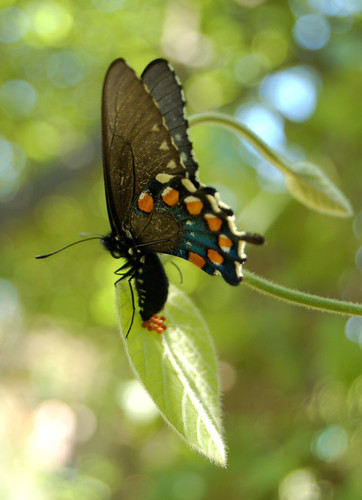Butterfly Breeding
...

I've been planting my garden with the needs of native animals in mind. I'm particularly interested in helping out the animals that depend on a single food source. So, I'm attempting to grow a variety of milkweeds, for the Monarch butterflies. (I'm fighting the slugs, who seem to love these plants.)
I'm also growing Dutchman's Pipe, which is the only plant that the larval Pipevine Swallowtail butterfly eats. Conveniently, the female butterfly also lays her eggs on this plant.

The weekend before last, Robb and I went on the Bringing Back the Natives garden tour, where we visited the garden of Idell Weydemeyer. I addition to incredible orchards, Idell grows a huge variety of California native plants. She had a friendly, informative volunteer stationed at the site of her impressive Dutchman's Pipe Vine, talking about the life cycle of these beautiful butterflies.
The butterflies were in attendance as well. The volunteer pointed out some eggs that had just been laid (top photo) and while I attempting to take photos of the swift, flitting butterflies, one settled down, and started laying eggs.
I have had my Dutchman's Pipe in pots for about six months, because I can't decide where to place them. I wonder if I might be able to adopt a caterpillar or three from someone who grows this plant. I'm doubtful that the butterflies will find my garden, all by themselves.
We have man butterflies in our urban garden, and it would be lovely to see some of these beauties.

I've been planting my garden with the needs of native animals in mind. I'm particularly interested in helping out the animals that depend on a single food source. So, I'm attempting to grow a variety of milkweeds, for the Monarch butterflies. (I'm fighting the slugs, who seem to love these plants.)
I'm also growing Dutchman's Pipe, which is the only plant that the larval Pipevine Swallowtail butterfly eats. Conveniently, the female butterfly also lays her eggs on this plant.

The weekend before last, Robb and I went on the Bringing Back the Natives garden tour, where we visited the garden of Idell Weydemeyer. I addition to incredible orchards, Idell grows a huge variety of California native plants. She had a friendly, informative volunteer stationed at the site of her impressive Dutchman's Pipe Vine, talking about the life cycle of these beautiful butterflies.
The butterflies were in attendance as well. The volunteer pointed out some eggs that had just been laid (top photo) and while I attempting to take photos of the swift, flitting butterflies, one settled down, and started laying eggs.
I have had my Dutchman's Pipe in pots for about six months, because I can't decide where to place them. I wonder if I might be able to adopt a caterpillar or three from someone who grows this plant. I'm doubtful that the butterflies will find my garden, all by themselves.
We have man butterflies in our urban garden, and it would be lovely to see some of these beauties.

Comments
Re pipevine swallowtails, I've heard that native ginger (Asarum canadense) is also a larval food.